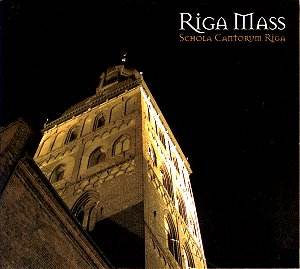Founded in 1995, the Schola Cantorum Riga (originally
the Schola Gregoriana Riga) started as a specialist ensemble for the
authentic interpretation of gregorian chant. It grew out of gregorian
chant weeks held each summer in Latvia. Gradually it became a group
with a comprehensive and varied repertoire. The group believes one of
its missions is to perform music by Latvian composers. Spiritual music
by contemporary Latvian musicians is part of the choir's repertoire
and the group enjoys the support of the Latvian composer Rihards Dubra
(known in the UK mainly for his fine approachable chant-inflected liturgical
music). The choir performs Dubra's music regularly and has released
a CD devoted to Dubra's music. Dubra was a founder member of the group
and is still keen participant in the choir's activities and sings on
this record.
The group numbers around 15 singers in full and their
routine includes both spiritual concerts and frequent participation
in church services. Their musical director, Guntars Pranis is the Cantor
of Riga Cathedral and teaches Gregorian Chant at the Latvian Music Academy.
On the current recording the group numbers 9 singers.
This ingenious recording uses propers taken from a
14th century manuscript (the Missale Rigense preserved at
Riga Cathedral) to construct an entire plainchant mass. The foundation
stone of Riga Cathedral was laid on July 24th 1211. The anniversary
of this date would probably have been celebrated with a mass - the Mass
for the Consecration of a Church. The propers for this mass are those
which have been preserved in the Riga manuscript.
This very evocative recording was made in Riga cathedral
and the cathedral's resonant acoustic almost becomes an additional performer.
The ordinary of the mass is sung to the plainchant
mass 'Kyrie fons bonitatis'. This mass is still in the contemporary
Liber, but the group here sing the Kyrie in its original troped form.
The plainchant of the Kyrie and the Agnus Dei were originally 10th
century whilst the Gloria and Sanctus date from the 13th
century. The Credo used is Credo I. Both this and the Pater Noster are
identical to that in current use today.
Most of the propers used are in the contemporary Liber,
but, as with all the chant on this record, there are slight differences
between what is sung and the modern versions of the chants. The record
is completed by a group of vespers chants for the consecration of a
church.
Generally, the Schola Cantorum sing the chant straight,
but the Kyrie includes some striking organum. And two of the vespers
chants are given a striking bass drone, in the orthodox manner (as in
the recordings of early Roman chant by Marcel Perez and his group).
On a stylistic issue, I am not sure whether their attitude to ornaments
and repeated notes represents a local tradition of an attempt at period
practice..
The chant is sung quite vigorously and swiftly but
with a good sense of line and shape. Not all the solo work is up the
generally high standard of the rest of the record. The Schola Cantorum
has a distinctive, but well blended sound. They pronounce latin in a
germanic manner with a slight accent, which only adds to the evocative
atmosphere of the recording. In an era of homogenisation, it is so pleasant
to come across a recording so firmly rooted in one place and one time.
Apart from the propers, I am a little unclear how much
of the remainder of the recording is taken from the Missale Rigense.
The recording contains only a background essay with neither texts nor
details of the changes. Some discussion of their performance practices
and the theoretical background to their performance would have been
welcome in the booklet.
Robert Hugill

